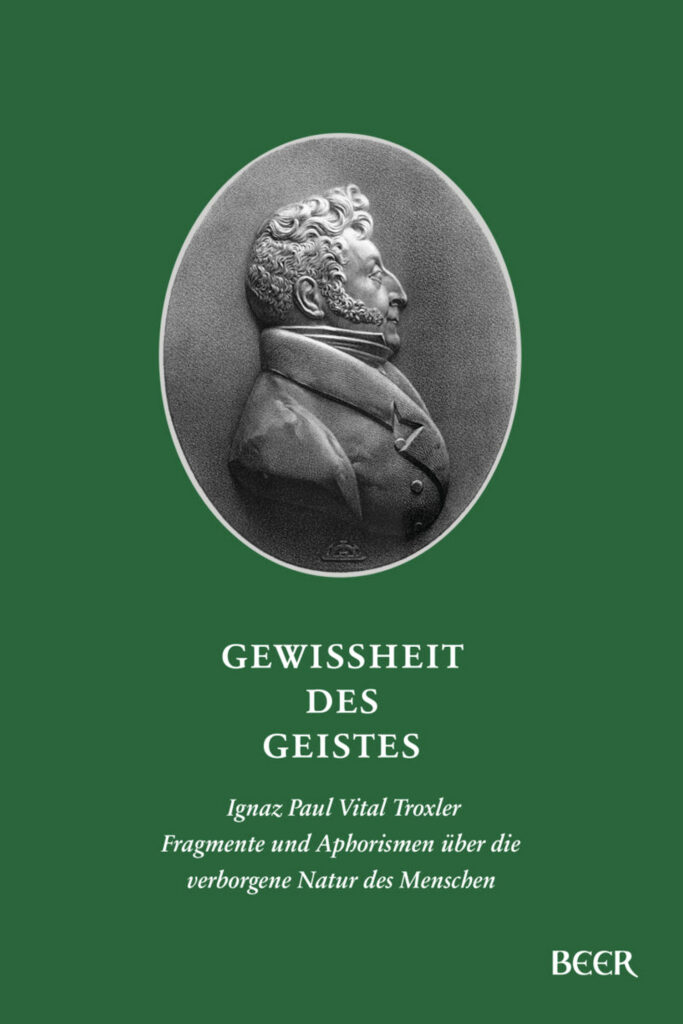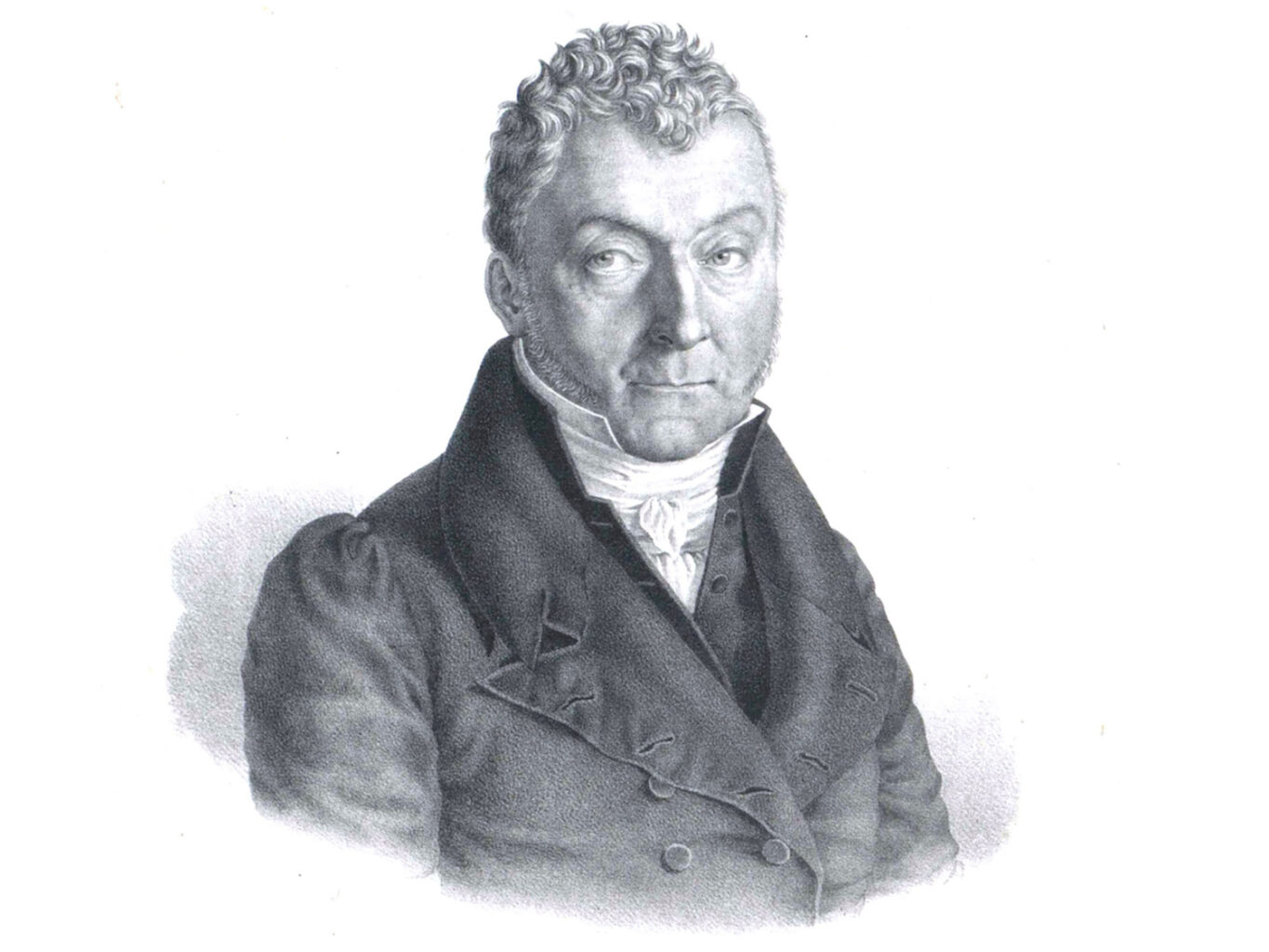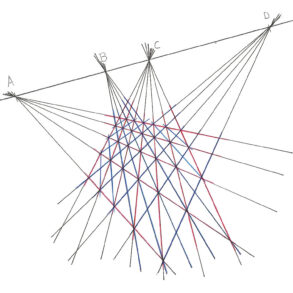In 2022, Beer Verlag reissued a work by Ignaz Troxler in which his aphoristic fragments are summarized under the title ‹The Certainty of the Spirit›. The book constitutes an essential document for work on the sources and fundamental concepts of anthroposophy. Moreover, it makes it possible to bring back to the fore the too often forgotten early anthroposophist – Ignaz Troxler.
Defining anthroposophy isn’t easy. Ignaz Troxler (1780–1866) can be regarded as a key figure in this field of research. The Swiss physician and philosopher can rightly be described as an ‹anthroposophist› because he endeavoured to formulate the meaning and basis of anthroposophy. Even though we generally define Rudolf Steiner as the founder of anthroposophy, Troxler’s historical figure challenges this statement because he lived before Steiner. It seems appropriate not to forget Troxler and his work if one wants to return to the origins of anthroposophy. Rudolf Steiner also mentioned Troxler repeatedly and regretted that his name had fallen into oblivion. In 1916, he emphasized that the presence of anthroposophy on Swiss soil wasn’t a novelty, as it was already present before the Goetheanum settled there, and that it was to be found precisely in Ignaz Troxler, who knew how to formulate «a beautiful, glorious definition of anthroposophy.»1
An Original Anthroposophy
When the origins of anthroposophy are spoken of, they are usually thought to refer first to the artists and thinkers of Goethe’s time, to natural philosophy and the German idealists. However, the word ‹anthroposophy› is not found in Goethe, nor in Novalis, Schiller, Hegel, Fichte, and only marginally in Schelling. The term appears in various 19th century thinkers, but it is in the work of Ignaz Troxler that the idea and the word ‹anthroposophy› really take effect. Troxler was a student of Hegel and Schelling and even became friends with the latter. He had the opportunity to assimilate all the fruits of Goethe’s time, and he designed, as it were, a synthesis of them, which he called ‹anthroposophy›.
The collection, newly published by Frieder Sprich at Beer-Verlag, contains numerous aphorisms by Ignaz Troxler, which had already been collected and arranged by Willi Aeppli for the 1958 edition published by Verlag Freies Geistesleben. The order has been somewhat rearranged, and the fragments have been provided with numerous comments. An overview of the individual chapters reveals a thematic landscape typical of anthroposophy, starting with ‹cognition of knowledge›, continuing with the ‹nature of man› and ‹pedagogy›, and ending with ‹Christology›.
From Thinking to Clairvoyance
At the beginning of his approach, Troxler focuses his attention and meditations on the capacity to think. What is philosophizing? What is recognition? What is thought? This is the central question that has moved philosophers from Descartes through Kant to Hegel, Fichte, and Schelling, and that will later be found in Steiner, Husserl, and other philosophers to this day. First, it is a matter of recognizing this mental activity of human nature in all its potential: «Thinking as an independent and free process of cognition is something far more powerful and glorious than one usually imagines it.» However, thought, usually used in an industrial civilization to understand and reshape the external world, remains the invisible, unobserved element in human activity. The point, then, is to focus attention on the thinking subject, on the thinking process as such.
Troxler makes a discovery: «The essence of thinking leads to thinking about essence.» Within the activity of thinking, Troxler experiences an essence, that is, a spiritual reality grounded in itself. A force that is aware of itself and has its cause in itself. Through this act of empirical observation of thinking consciousness, he observes that a transformation occurs: The action of thinking begins to rise to a qualitatively higher level. A dimension of ‹contemplation› arises: «Mental perception is the supreme and innermost fact of complete self-consciousness – and there is as little proof of this as there is to whether a human being can have their freedom and unconditional self-determination proven to them.»
Troxler sees in this ‹thinking about thinking› not only the foundation for a spiritual outlook, but also – and this is crucial: it is the place where freedom is exercised. This is not a matter of theoretical speculation, but of experience, an experience of consciousness, an experimental field, even though the nature of this experience makes it impossible to provide any external proof of it. How could one not recognize here the central experience which Steiner formulates in his ‹The Philosophy of Freedom›: «One who observes thinking, lives during this observation directly within a self-supporting, spiritual web of being. Yes, one can say that whoever wants to grasp the essence of the spiritual in the form in which it first presents itself to humanity can do so in thinking based on itself.»2
Troxler describes this spiritual consciousness, which is developed on the basis of autonomous thinking observing itself, as clairvoyance: «However, this philosophy is based on a higher, inner consciousness. I would like to say, on a self-conscious, free clairvoyance […]» Therefore, it is a development of thinking that reaches the degree of ‹contemplative thinking› or ‹clairvoyant thinking.›

Basic Elements of Anthroposophy
In contrast to older spiritual approaches, the spiritual perception described by Troxler doesn’t contradict the ability to reason but develops based upon rational consciousness. It is this development of consciousness that Troxler will call ‹anthroposophy›. Not primarily a collection of specific ideas, not an ideology. To this end, he offers an astonishing and inspiring definition of those he calls ‹anthroposophists›: «Anthroposophists are the philosophers of perception and knowledge.» Troxler even speaks of a new ‹organ› of knowledge: «The completion of philosophy in anthroposophy requires nothing less than an entirely new point of view above all reflection and speculation, a peculiar, higher organ of consciousness and knowledge.»
The cognitive activity of this new knowledge organ doesn’t lead to a solidified, cold, or dogmatic knowledge: «Anthroposophy has the character of a creative, invigorating, and animating principle.» Troxler certainly has a new spiritual-science in mind: «But the time will come – and it is near – when anthroposophy will explain the natural phenomenon of the spirit realm to the spirit in human beings, just as physics explains the rainbow to the face and the aeolian harp to the ear.» He also sees that this spiritual-science has the potential to comprehensively change the sciences and practical activities of human life: «And the theologian and philosopher, the lawyer and politician, the physician and pedagogue will turn to this actual study of spiritual sources and draw from them guiding ideas and maxims. But for this very reason anthroposophy must also embrace all fields of these sciences and efficacies.»
It is a matter of bringing human consciousness and the potential for the freedom it contains back into focus. The human being is neither only an externally determined physical being, nor only a completely free and autonomous spiritual being, our reality rather lies in the connection of these two elements: This is what anthroposophy points out and describes.
Human Nature
In human beings, spirit and matter unite. Anthroposophy wants to explore the human being and thereby overcome this division. «The spirit immaterial and the body thought of as mere matter is the reason for all disunity and the decomposition of the human being into ghost and corpse, whereby all development and transformation are made impossible.» It is crucial to understand and perceive the interactions between body and mind. Troxler succeeds in distinguishing between several members of the being. Beyond ‹body› and ‹spirit› he sees the need to recognize a ‹soul› as well. However, he discovers this isn’t enough: «Vegetable life or organic activity, which presents the formation of the whole body, can no more be explained by external mechanical or chemical natural forces than by the soul and its faculty.» Therefore, he must also distinguish the plant element, the actual living one, and he will call it a specific ‹body›.
In his meditative contemplation, Troxler thus arrives at that fourfold division of humans: flesh, body, soul, and spirit, which he calls the ‹Tetractys›. He points out however that another element must be added that ensures the unity of the whole. He describes this fifth element as the ‹quintessence›: «Henceforth, I may speak only of physical, soul-body and spiritual life, and must accept as the quintessence or the being common to all this life, the divine-human unity, the pneuma-somatic and soma-pneumatic, the primordial foundation and consummation of human nature, which Jesus-Christ revealed bodily in his transfigurations and resurrection.»
At various points, Steiner comments on these tetractys and Troxler’s view and connect them precisely with his own descriptions of the ‹essence› of human beings. Thus, it becomes clear how, based on spiritual empirical research, Troxler already arrives at basic concepts that make it possible to think organically about the connection between mind and body. He summarizes this in the sentence: «Spirit is the cause, the primordial ground and primordial goal, the center is made the soul, the body is the tool and effect.»
Pedagogical Perspective
Based on this path of knowledge which does justice to the full potential of human freedom, Troxler pays special attention to the pedagogical question. For him, the pedagogical concepts of his time are problematic: «In no area have more experiments been done than in the field of education. However, in hardly any subject have more errors been spread, grosser and more harmful mistakes made than in the pedagogical one. This was bound to happen, for as long as the essence of human nature was misunderstood, its conditions distorted, and the true destiny of humanity disregarded.»
His anthroposophical perspective on human nature leads him to promote an education of the whole person: «If you want to educate the whole person, choose whole people as teachers.» In doing so, he outlines some ideas that we can clearly find in the principles of Waldorf education. He emphasizes that education should not be focused only on the head: «Consider that knowledge which dwells only in the head, and not as knowledge in the heart, is deaf fruit.» He recognizes the peculiarity of the child’s consciousness and the necessity of not spoiling it too early: «All children are prophets and poets, and we disturb too early the free, pure natural course of development by reversing the direction of life and by working into it – it dreams, but certainly of a future world.»

The goal is to educate free people who stand on a secure foundation within themselves: «Formation of mind is as important as formation of spirit. But as little as the latter consists in the communication of true and false, equally little does the latter consist in the formation of good or evil. We must educate the mind to consciousness and self-knowledge, the soul to free activity and willpower – character formation – which is morally and legally good. To realize this is another matter – a matter of the spirit. However, to want, to be able, and to do this is a matter of the mind. The highest character is that of the enlightened self-thinker and the well-meaning, free-willed person.»
For the Freedom of Spiritual Life
Troxler’s reflections on pedagogy lead him to present some approaches to the social organism. Troxler also dealt with politics and contributed significantly to the development of the political structure of modern Switzerland.3 In his conception of the social organism, Troxler emphasizes the central importance of a free spiritual life. It is necessary, he said, to separate the school from church and state: «Above all, the school, like the church and the state and the home, a separate area with autonomy and independence – neither imperialist nor papist, and not state nor ecclesiastical, Catholic or Protestant.» He also regarded it as the greatest sacrilege «when the secular or spiritual ruler presumes power or authority over the free development of the mind in education and school.» This applies not only to schools but also to higher education: «The universities are there neither for the states nor for the church.»
And like Steiner, Troxler sees in this free spiritual life the potential for revitalizing all social life, because from such a free educational organization «will emanate the light and power that the promise of the spirit has to rejuvenate the world.»
From Creature to Creator
Anthroposophy recognizes humanity’s absolute potential for freedom and makes it possible to understand them no longer as a creature but as a creator. In contrast to the old view, which saw in the human being only the creature of a God standing outside them, and in contrast to the modern view, which sees in them only the result of external, material, or environmental causes, anthroposophy recognizes in the human being this active spiritual dimension, this ‹archae› (beginning,) this origin, which has its cause in itself.
Troxler describes how his philosophy (anthroposophy) leads to this creative dimension at the level of knowledge: «Nothing enlightens the philosopher’s intellectual outlook to which they aspire, like the imaginative or poetic representation, which emanates from the fantasy potentiated to creative genius.» Therefore, the forms of knowledge to which such an anthroposophical approach lead also have the character of imagination and poetry: «The actual philosophy of Sophia, revealed from within and without, is the mother of thinking and poetic poetry, germinating and taking root on sensuality and primordial imagination. Therefore, perception and knowledge (image and concept) lie united and undivided, in the first spiritual references, as in the oldest documents of the human race.»
Perspectives of a Christology
Due to its nature and logical and empirical development, anthroposophy leads to an understanding of Christ as a universal human experience. It is not a matter of an external influence of the divine on humanity, but of the autonomous and free expression of the spiritual made possible by this connection of material and spiritual existence in the human being: «The so-called supernatural is the higher inner nature of humanity, not an external, alien influence upon nature, not a mere influence of the divine upon the human, but the physical and metaphysical unity of both as revealed in and through Christ, and the image of God is and remains latent in all of humanity unless awakened by the homogeneous inspiration of the God-human.»
This Christology doesn’t spring from faith but from an activity of knowledge that can see a unique moment in the evolution of humanity: «The divine is innate to us, but could only be revealed and become effective through the influence of a God-Man. This is He alone. But just as all things have a divine reason, human beings have a divine spark within them, which lies dormant in their latent supernature.» A view that foreshadows how the Christ event forms the universal basis for humanity’s potential for freedom – the moment when the creature can become the creator, in which the divine principle (archae) appears within humans. «The doctrine of Christ reverses everything,» Troxler writes. We can initially perceive here how an anthroposophical approach opens not only a new insight into the human being, but also an insight into the spiritual development of humanity and cosmology.
A Definition?
As we’ve skimmed through this collection of aphorisms, we’ve tried to show how inspiring the study of Troxler as a historical personality and as an anthroposophist can be. The force of this which emerges in these fragments can be very helpful in grasping more precisely the core concepts of the anthroposophical approach. They can also help to better understand the extremely simple definition that Rudolf Steiner gave to the Oxford dictionary: «Anthroposophy is a knowledge produced by the Higher Self in man.»
Translation Monika Werner
Book Karl Friedrich Sprich (Hg.), Gewissheit des Geistes [Certainty of the Spirit.] Ignaz Paul Vital Troxler. Fragmente und Aphorismen über die verborgene Natur des Menschen [Fragments and Aphorisms about the Hidden Nature of Humanity.] Beer Verlag, 2022
Footnotes
- Rudolf Steiner, Innere Entwicklungsimpulse der Menschheit [Inner Development Impulses of Humanity.] 16. Lecture, Dornach, October 30, 1916, GA 171.
- Rudolf Steiner, Die Philosophie der Freiheit [The Philosophy of Freedom.] GA 004.
- Olivier Pauchard, ‹Ignaz Troxler, der vergessene Erfinder der modernen Schweiz› [Ignaz Troxler, the Forgotten Inventor of Modern Switzerland], swissinfo.ch, March 14, 2021









